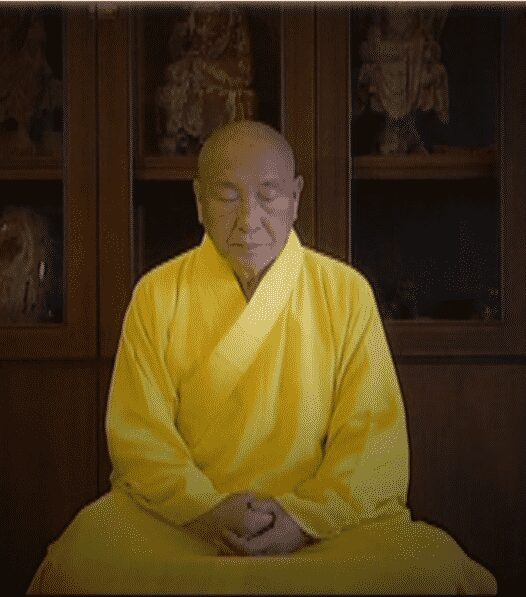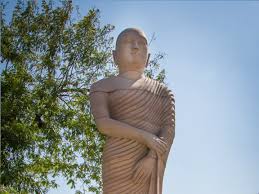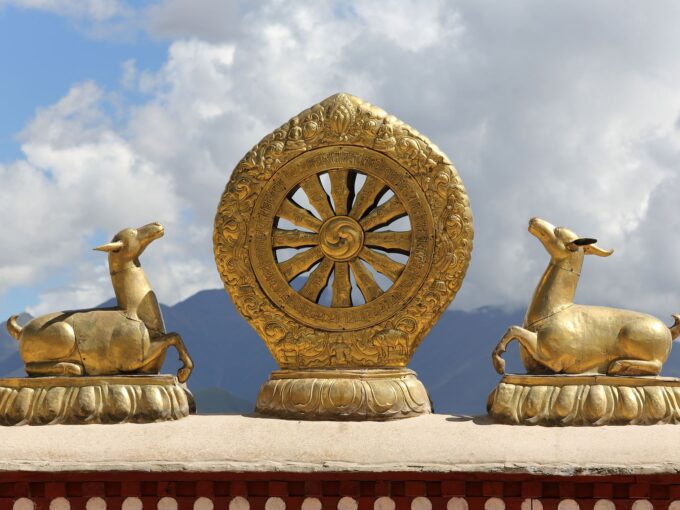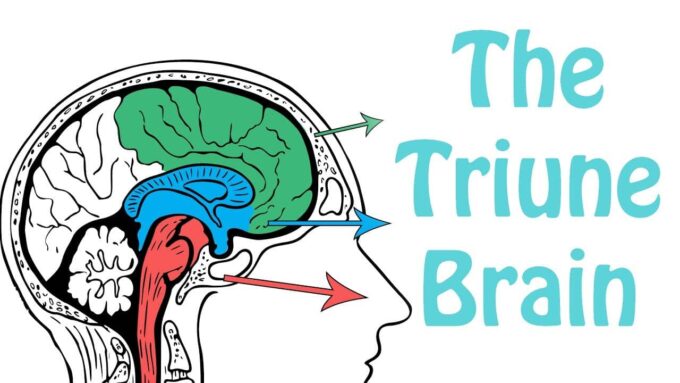The growth in Chan (Zen) toward an established place in Chinese life began to consolidate under the Fourth Ancestor, Dayi Daoxin, whose life spanned the Sui and the early Tang dynasties.
Dayi Daoxin, (Japanese: Doshin) (580–651) also called Ssu-Ma, born at or near Huai-ning, Anhwei, north of the Yellow River, was the fourth Zen Buddhist Patriarch, following Jianzhi Sengcan (Seng-ts’an; Japanese: Kanchi Sosan) and preceding Hongren. He began to study Buddhism at the age of seven. According to the Compendium of Five Lamps, Daoxin met Sengcan when he was fourteen.
The following exchange occurred:
‘I beg you, Master, to show me your compassion and lead me to the Dharma-gate of liberation.’
‘Who has bound you?’ Seng-ts’an replied.
‘Nobody has bound me,’ answered the monk.
‘That being the case,’ said the master, ‘why should you continue to seek for liberation?’
Upon hearing these words, Daoxin enlightened.
Daoxin received the ordination as a monk in 607. He learned under Sengcan for nine years, until Sengcan went to Mount Lo-fu.
For ten years he studied with Zhikai in the Great Forest monastery on Hermitage Mountain (Lushan) in northern Jiangxi. This monastery was a famous center of learning for the Tiantai School, and for the study of the Prajna Paramita scriptures, both of which likely influenced Daoxin’s practice and teaching.
In 617, Daoxin and some of his students traveled to Ji Province and Daoxin finally settled at the Temple Mount East in Shuangfeng ( “Twin Peaks”) where he taught Buddhism Chan for thirty years and attract a large number of practitioners – some records say five hundred laypeople and monks.
According to Keizan, Daoxin returned to Qi province in 624, where he met his future successor, Hung-jen (Hongren).
*
In 643 Emperor Tai Zong invited Daoxin to the capital, but Daoxin refused to come. Three times the emperor sent emissaries, and three times Daoxin declined the invitation. The last time, the Emperor instructed the emissary to bring Daoxin alive or his head. When the messenger wanted to execute the instructions, Daoxin surrendered, allowing the delegates to take off his head. The emissary was shocked and then he reported this incident to the emperor, who then respected Daoxin as an exemplary Buddhist monk.
*
In the year 651, Daoxin commanded his disciples to build a stupa because he will soon die. He said to his disciples, “All things are liberated. You should keep mindful of this and teach it in the future.” He then passed away, sitting peacefully.
Keizan called him ‘an extraordinary man, the kind we meet once in a thousand years. Also, in The Transmission of Light, Keizan tells us that after succeeding to the Way, Daoxin concentrated his mind without sleeping and never lay down for the remaining 67 years of his life.
Emperor Dai Zong honored Daoxin posthumously with the title “Dayi “(Healer).
Although the Fourth Ancestor’s teachings are not well known, he is recognized for:
- his dedication to meditation
- forming the first self-supporting monastery
- combining Chan practice with more popular Buddhist practices, thus broadening its appeal
Daoxin appears to have been particularly dedicated to meditation, practicing it more avidly than had any dhyana master since Bodhidharma. He supposedly devised and promoted new techniques to help novices achieve intensive meditation.
The Daoxin’s Doctrine (and its successor, Hongren) is known as the East Mountain Doctrine, and it constitutes the beginning of the development of Chan on a national scale. Daoxin is the Chan master who were first to settle in one place for a longer time, who developed a stable community life that will lead to monastic Chan communities throughout China.
Daoxin helped by offering the Chan (Zen) teaching and practice a more stable and centralized home in a monastic community. The Lankavatara Sutra was already influential in Zen circles, and Daoxin added an emphasis on the Prajna Paramita scriptures, particularly the Heart and Diamond Sutras. Master Daoxin was also known as a skilled practitioner of traditional medicine and healing arts.
Quotes:
“Some people can see clearly that the mind is lucid and pure like a bright mirror. Some need a year of practice, and then the mind becomes lucid and pure. Others need three or five years, and then the mind is lucid and clear. Or some can attain enlightenment by being taught by someone else. The Nirvana Sutra says: ‘The nature of the mind of beings is like a pearl which falls into the water. The water is muddy so the pearl becomes hidden. When the water is pure, the pearl is revealed.’
“When you are sitting in meditation, watch carefully to know when your consciousness starts to move. Consciousness is always moving and flowing. According to its coming and going, we must all be aware of it. Use the wisdom of a diamond to control and rule it, since just like a plant, there is nothing to know. To know there is nothing to know is the wisdom to know everything. This is the Dharma-gate of One Form of a Bodhisattva.”
”The hundred thousand gates of the Awakened Teaching all return to the one heart. The source of the countless sublime practices all come from this one mind. All of the precepts and ethical guidelines, the practice of meditation, the gate of primordial wisdom and all its miraculous manifestations are all your natural possession, not separate from your mind. Every type of misfortune and karmic impediment is fundamentally empty and without substantial existence. All causes and effects are simply dreams and illusions. There are no suffering worlds to escape from and there is no awakening to search for. The original nature, and the outer appearance of humans and all beings, are identical. The great way is empty and boundless, free from thought and anxiety. If you have merged with this truth, where nothing whatsoever is lacking, what difference is there between yourself and an awakened one? Here there is not a single teaching left. You are just free to abide in your own spontaneous nature. There is no need to contemplate your behavior, no need to practice purifying austerities. Free from desires, having a heart without anger or cares, completely at ease and without impediment; free to go in any direction according to conditions; with no need to deliberately take on any good or evil affairs. In walking, standing, sitting, and lying down, whatever meets your eyes is nothing other than the essential source; all of it just the sublime function of awakening; joyful and carefree. This is called “Buddha.” From Five Lamps Merged in the Source (Wudeng Huiyuan , 1253, using earlier materials). Based on translations by Andy Ferguson, Thomas Cleary, and C.H. Wu
photo credit : it.wiki




